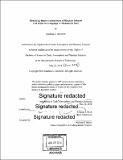Identifying binary central stars of planetary nebulae with Kepler K2 campaign 11 photometric data
Author(s)
Hurowitz, Jonathan L
DownloadFull printable version (8.162Mb)
Other Contributors
Massachusetts Institute of Technology. Department of Earth, Atmospheric, and Planetary Sciences.
Advisor
Amanda S. Bosh.
Terms of use
Metadata
Show full item recordAbstract
A large majority of planetary nebulae (PNe) are non-spherical, and many have complex structures; these are unlikely to be created trivially by a single central star. The Binary Hypothesis proposes that the complex morphologies of most non-spherical PNe are caused by interactions between their central stars and companions, with some unknown percentage in close binary systems. In this study, a software pipeline was developed to generate light curves for 140 PNe targets from the Kepler K2 campaign 11 field. Of these 140 targets, 29 appeared to show periodicity in their light curves, all of which had period under two weeks, for a close binary fraction of 21%; furthermore, 25 out of 29 (86%) detected periods were between two hours and five days. The size of this data set (140 PNe) is larger than any previous photometric search for close binary companions of PNe central stars, and the calculated short-period binary fraction is consistent with past photometric searches. These results support the Binary Hypothesis, which in turn helps explain the development of the varied and complex morphologies of PNe.
Description
Thesis: S.B., Massachusetts Institute of Technology, Department of Earth, Atmospheric, and Planetary Sciences, 2018. Cataloged from PDF version of thesis. Includes bibliographical references (pages 24-26).
Date issued
2018Department
Massachusetts Institute of Technology. Department of Earth, Atmospheric, and Planetary SciencesPublisher
Massachusetts Institute of Technology
Keywords
Earth, Atmospheric, and Planetary Sciences.